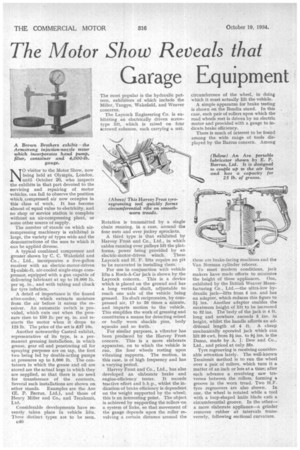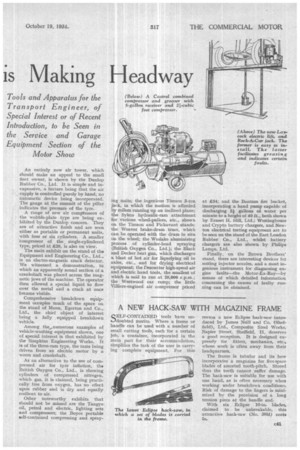The Motor Show Reveals that
Page 62

Page 63

If you've noticed an error in this article please click here to report it so we can fix it.
Garage Equipment
is Making Headway
Tools and Apparatus for the Transport Engineer, of Special Interest or of Recent Introduction, to be Seen in the Service and Garage Equipment Section of the Motor Show
gauge.
NO visitor to the Motor Show, now being held at Olympia, London, until October 20, who inspects the exhibits in that part devoted to the servicing and repairing of motor vehicles, can fail to observe the position which compressed air now occupies in this class of work. It has become almost of equal value to electricity, and no shop or service station is complete without an air-compressing plant, or some other source of supply.
The number of stands on which aircompressing machinery is exhibited is large, the variety of types wide and the demonstrations of the uses to which it can be applied diverse.
A typical combined compressor and greaser shown by C. C. Wakefield and Co., Ltd., incorporates a five-gallon receiver with an electric-motor-driven 2k-cubic-ft. air-cooled single-stage compressor, equipped with a gun capable of delivering lubricant at up to 10,000 lb. per sq. in., and with tubing and chuck for tyre inflation.
A detail of importance is the finned after-cooler, which extracts moisture from the air before it enters the receiver. An automatic switch is provided, which cuts out when the pressure rises to 150 lb. per sq. in. and restarts the motor when it drops to 125 lb. The price of the set is £37 10s.
Another noteworthy Castrol exhibit, representative of its type, is a permanent greasing installation, in which grease, gear oil and penetrating oil for spraying purposes are on tap, the first two being fed by double-acting pumps at pressures up to 5,000 lb. The containers in which the grease and oil are stored are the actual kegs in which they are supplied, so that there is no need for transference of the contents. Several such installations are shown on other stands. Examples are the Aro (E. P. Barrus, Ltd.), and those of Henry Miller and Co., and Tecalemit, Ltd.
Considerable developments have recently taken place in vehicle lifts. Three distinct types are to be seen. The most popular is the hydraulic pattern. exhibitors of which include the Miller, Tangye, Wakefield, and Weaver concerns.
The Laycock Engineering Co, is exhibiting an electrically driven screwtype lift, which is raised on four iacrewed columns, each carrying a nut.
Rotation is transmitted by a single chain running, in a case, around the four nuts and over jockey sprockets.
A third type is that exhibited by Harvey Frost and Co., Ltd., in which cables running over pulleys lift the platforms, power being provided by an electric-motor-driven winch. These Laycock and H. F. lifts require no pit to be excavated in installing them.
For use in conjunction with vehicle lifts a Rock-A-Car jack is shown by the Laycock concern. This is a device which is placed on the ground and has a long vertical shaft, adjustable to reach one axle of the vehicle being greased. Its shaft reciprocates, by compressed air, 17 to 20 times a minute, and imparts motion to the vehicle. This simplifies the work of greasing and constitutes a means for detecting seized or badly worn shackle pins, body squeaks and so forth.
For similar purposes, a vibrator has been produced by the Harvey Frost concern. This is a more elaborate apparatus, on to which the vehicle is run, the four wheels resting upon vibrating supports. The motion, in this case, is of high frequency and has a varying period.
Harvey Frost and Co., Ltd., has also developed an elaborate brake and engine-efficiency tester. It records tractive effort and b.h.p., whilst the indication of brake efficiency is dependent, on the weight supported by the wheel; this is an interesting point. The object is achieved by supporting the rollers on a system of links, so that movement of the gauge depends upon the roller revolving a certain distance around the circumference of the wheel, in doing which it must actually lift the vehicle.
A simple apparatus for brake testing is shown on the Bendix stand. In this case, each pair of rollers upon which the road wheels rest is driven by an electric motor and provided with a gauge to indicate brake efficiency.
There is much of interest to be found among the wide range of tools displayed by the Barrus concern. Among these are brake-facing machines and the Van Norman cylinder reborer.
To meet modern conditions, jack makers have made efforts to minimize the height of these appliances. One, exhibited by the British Weaver Manufacturing Co., Ltd.—the ultra-low hydraulic jack—lifts from 5 ins, and has an adapter, which reduces this figure -to 21 ins. Another adapter enables the maximum height of lift to be increased to 32 ins. The' body of the jack is 4 ft. long and nowhere exceeds 5 ins, in height, whilst the handle affords an additional length of 4 ft. A cheap mechanically operated jack which can lift 30 cwt. from 3,1 ins. to 9. ins, is the Dumo, made by A. J. Dew and Co., Ltd., and priced at only 35s.
Tyre regrooving is receiving considerable attention lately. The well-known Tecalemit method is to run the wheel over a pair of rollers, which turn it a matter of an inch or less at a time; after each advance a revolving saw traverses between the rollers, forming a groove in the worn tread. Two H.F. tyre regroovers are also shown. In one, the wheel is rotated while a tool with a loop-shaped knife blade cuts a circumferential groove. In the other— a more elaborate appliance—a grinder removes rubber at intervals transversely, following sectional curvature. An entirely new air tower, which should make an appeal to the small fleet owner, is shown by the Dunlop Rubber Co., Ltd. It is simple and inexpensive, a feature being that the air supply is controlled purely by hand, no automatic device being incorporated. The gauge at the summit of the pillar indicates the pressure of the tyre.
A range of new air comptessors of the wobble-plate type are being exhibited by the Dunlop concern. They are of attractive finish and are seen either as portable or permanent units, with four or six cylinders. A smaller compressor of the single-cylindered type, priced at £20, is also on view.
The main exhibit on the stand of the Equipment and Engineering Co., Ltd., is an electro-magnetic crack detector. We witnessed a demonstration, in which an apparently sound section of a crankshaft was placed across the magnetic jaws of the machine. The operator then allowed a special liquid to flow over the metal and a crack at once became visible.
Comprehensive breakdown equipment occupies much of the space on the stand of Mann, Egerton and Co.. Ltd., the chief object of interest being a fully . equipped breakdown vehicle.
Among the.,,numerous examples of vehicle-washing equipment shown, one of special interest is that exhibited by the Simpkins Engineering Works. It is of the three-ram type, the rams being driven from an electric motor by a worm and crankshaft.
As an alternative to the use of compressed air for tyre inflation, the British Oxygen Co., Ltd., is showing cylinders of compressed nitrogen, which gas, it is claimed, being practically free from oxygen, has no effect upon rubber and is dry and equally resilient to air.
Other noteworthy exhibits that should not be missed are the Tangye• oil, petrol and electric, lighting sets and compressors; the Boyce portable self-contained compressing and spray lug units; the ingenious Timson 3-ton jack, in which the motion is afforded by rollers running up an inclined plane; the Sykco hydraulic-ram attachment for various wheel-pullers, etc., shown on the Timson and Pickavant stands; the Weaver brake-drum truer, which can be operated with the drum in situ on the wheel; the Weslake aluminizing process of cylinder-head spraying (British Oxygen Co., Ltd.); the Black and Decker heat gun, which discharges a blast of hot air for liquefying oil in axles, etc., and for drying electrical equipment; the Desoutter high-speed air and electric hand tools, the smallest of which is said to run at 20,000 r.p.m.; the Westwood car ramp; the little Villiers-engined air compressor priced
at £34; and the Bantam fire bucket, incorporating a hand pump capable of discharging 2i gallons of water per minute to a height of 40 ft., both shown by Ernest H. Hill, Ltd.; Westinghouse and Cry-pto battery chargers, and Newton electrical testing equipment are to be seen on the stand of the East London Rubber Co., Ltd., whilst battery chargers are also shown by Philips Lamps, Ltd.
Finally, on the Brown Brothers' stand, there are interesting devices for setting injector nozzles, and a most ingenious instrument for diagnosing engine faults—the Motor-Ex-Ray—by means of which detailed information concerning the causes of faulty running can be obtained.












































































































